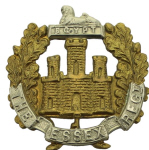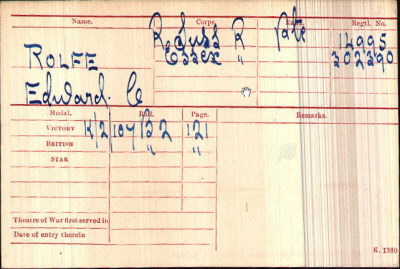



302390, Private, Edward Claude ROLFE
Aged 19

|
Born in Bury St.Edmunds on 26th June 1898 [Bury St.Edmunds 4a:842], baptised Bury St.Edmunds 10 July 1898, the eldest son of Thomas and Alice Mahala ROLFE
(née ROGERS) of 24 Whiting Street, Bury St Edmunds.
1901 census...Edward [2] was at 21 Whiting Street, Bury St Edmunds with his father Thomas [35], a french polisher born Bury St Edmunds; his mother Alice [36] born Norwich and his brother Cyril [1] born Bury St Edmunds. 1911 census...Edward [12] was at 2 Duxford Terrace, Cheveley Road, Newmarket with his parents (father now a house painter) and sister Lilian Mirriam [6] and grandfather Fredric Robert ROGERS. His brother Cyril had died in 1902. He enlisted in Cambridge, No.4028 in the Cambridgeshire Regiment. |

|
It was part of the Battle for Cambrai. Lieutenant Colonel John Fuller the Chief of Staff of the infant Tank Corps had devised an ingenious plan to show once
and for all what tanks could really do given the right circumstances such as surprise, and more importantly dry ground. Fuller's original plan had merely
been on the scale of a raid, and had suggested that the terrain between Cambrai and St Quentin had been ideal for a sudden but brief attack by tanks, which
could crush the German wire, allow the infantry through to widen the breach, and then let the cavalry exploit eastwards into open country. Fuller had revised
his plan during August 1917. By this time his simple lightening raid had developed into a larger scale operation whereby a mass of tanks would make a ‘raid
on Cambrai to spread 'alarm and despondency' after smashing their way through the Hindenburg Line before making a rapid return to base, the overall operation
taking no longer than eight hours. In the event the first day was a great success, but then plans changed and the attack continued and began to bog down. After a gas attack on Bourlon Wood on the 28th, the Germans began their counter attack,inflicting grievous casualties on the 12th (Eastern Division). The salient created by the initial Britsh advance had now become almsot encircled and General Byng was forced to order a retreat to shorten the British line. Over 2,700 British soldiers died on the 30th November 1917, amongst them the 1st, 9th and 13th Battalions of the Essex Regiment who lost a total of 92 killed, only 4 of which have identified graves. |



click here to go to the Commonwealth War Graves Commission website for full cemetery/memorial details